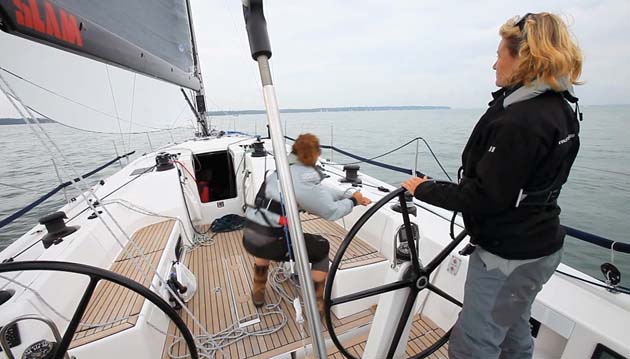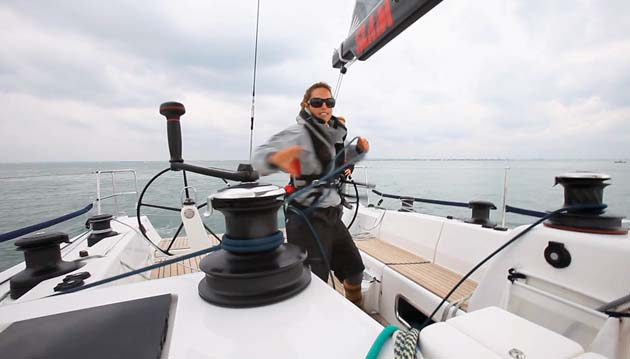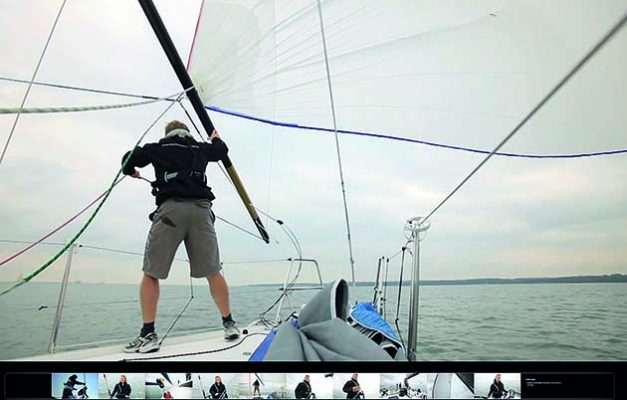In the third part of our 12-part series on advanced sailing techniques, professional sailor and coach Pip Hare describes how to gybe a spinnaker successfully
![]()
The first time I gybed single-handed it was on a 40-footer with a symmetrical spinnaker. The task seemed insurmountable and I struggled to see how any person could do this difficult manoeuvre single-handed.
But it can be done by breaking down the task into component stages and focusing on preparation and timing.
This article aims to highlight some of the vital elements of a successful gybe, whether you’re sailing short-handed or fully crewed.
See our video of SAIL FASTER SAIL SAFER Part 3, where you can watch two of us successfully gybe a 44-footer
Symmetric spinnaker
My goal here is to make sure the kite is flying well throughout in order to avoid wraps. Ensure the sail is stable and under control before the gybe.
Preparation
Once on a downwind course, square the pole back and fly the spinnaker out to windward to ensure it’s not hidden behind the mainsail.
Consider pulling on the tweakers, bringing the sheeting angle forward to help keep the kite more stable.
Pull on the lazy sheet to ensure it is taking the weight of the windward clew before releasing the guy, so the spinnaker is flying on the sheets alone.
Top tip
If the windward sheet is not tight enough when you release the guy, the spinnaker can blow forward, making the sail unstable. If this happens, don’t carry on with the gybe procedure. Instead, take time to wind on the windward sheet and get the spinnaker flying again before retrying the manoeuvre.
Gybing the spinnaker
With enough crew, the spinnaker should be rotated around the front of the boat, by easing the old sheet while pulling on the new one in time with the boat’s rate of turn. If short-handed, a good tip is to keep the spinnaker positioned on the windward side while you go into the gybe. Lock off the sheets and gybe through a slightly larger angle than normal, exiting a little higher than you usually would, so the spinnaker is being blown to leeward away from the forestay and the risk of a wrap.
Gybing the pole

There are too many techniques to cover here, but there are some vital points to note. First, during the gybe, there should be no load on the pole, so check the guys, uphaul and downhaul are free to run as needed.
Second, to prevent rips in the spinnaker (and help your foredeck crew), the cockpit crew must be looking forward, not down.
Exiting the gybe

The helmsman should come out of the gybe at a rate which matches the trim of the spinnaker and the time it takes for pole to be ‘made’ on the new side. As with all of the above, this will differ by boat according to the number of crew and their ability.
Asymmetric spinnaker
This time the key to success is the rate of the turn and watching the passage of the clew around the front of the boat like a hawk.
Preparation
Take time to prepare the cockpit, flaking the leeward sheet so it will run out without snags. Load the new sheet onto a winch and pull on the tackline to give a hard leading edge and a more controllable sail. If outside gybing make sure the new sheet has not fallen under the bow.
Outside gybe

The helmsman will aim to steer the boat quickly through the gybe onto the new course, keeping the apparent wind high enough to blow the clew forward round the front of the luff – like a barn door swinging open. The lighter the wind, the faster the turn.
As soon as the helmsman starts the turn, the trimmer must release the old sheet to allow the sail to fly forward. Any snags here will hamper the process, so that by the time the boat has turned downwind the force of the apparent wind might not be enough to carry the clew around the front of the boat.
Once the clew has passed the centreline of the boat, pull like crazy on the new sheet.
If there is a snag going into the gybe, it is often better to stop the manoeuvre, come back onto the breeze, refill the spinnaker and start again to avoid a wrap. If there is no snag, but not enough pressure to float the clew around the forestay try starting at a higher angle and gybing a little faster.
For a fuller explanation of the outside gybe see Pip’s Short-handed special HERE
Inside gybe

While this can be a slower turn than outside gybing, the passage of the clew remains all-important. This time, as the helmsman bears away, the trimmer will ease the old sheet until the clew is just forward of the forestay and has room to pass around it. Try marking the sheets, so you will know exactly where this is in the dark.
Pull on the new sheet as the old one is being eased, so that when the clew is level with the forestay the new sheet is ready to take the load. Once the new sheet has control of the clew, let the old sheet go completely and pull hard. The foredeck crew can help considerably if they pull the new sheet around from the foredeck.
Key point
The further forward of the forestay the clew passes, the more the body of the spinnaker will overtake the luff and risk a wineglass wrap. Co-ordination between the helmsman and trimmers is vital.
Gybing the main
With sufficient crew aboard the main can swing across the boat; appoint a crewmember to watch the apparent wind angle and the leech of the main for an indication of when it will go.
If short-handed, consider sheeting in the main and locking it off for the whole manoeuvre, thereby giving one less thing to think about. However, remember that this can make it harder to steer in quartering seas.
Inside or outside gybe?
The bigger the gap between the end of your pole and the forestay, the easier it is to do an inside gybe, and vice versa. Inside gybing is generally easier in lighter airs; outside gybing is preferable in stronger winds.

Top tips
- Once the gybe is complete, tidy up: coil ropes, clear winches and make sure you are ready to gybe again or perform a quick drop. Even more important at night.
- Talk through the manoeuvre before you execute it – tired solo sailors often write down the steps involved, just to make sure they will not miss anything out.
- Keep your eyes forward and keep the communication flowing – if you have a problem, let people know immediately.
- A great way to clear a wrap created while gybing is to gybe back immediately.
 Single-handed ocean sailor Pip Hare has clocked up thousands of miles racing and cruising. Among her achievements are five solo transatlantics, including the OSTAR and two Mini Transat races. She also works full-time for the RNLI on sea safety and is Consulting Editor on Yachting World. See also her series on short-handed sailing
Single-handed ocean sailor Pip Hare has clocked up thousands of miles racing and cruising. Among her achievements are five solo transatlantics, including the OSTAR and two Mini Transat races. She also works full-time for the RNLI on sea safety and is Consulting Editor on Yachting World. See also her series on short-handed sailing
SAIL FASTER SAIL SAFER Part 4: Pip Hare considers how to trim your sails for optimum performance – and comfort – upwind
12 part series in association with Pantaenius




